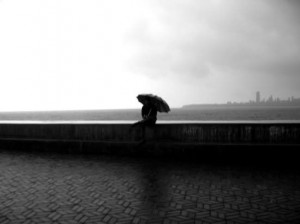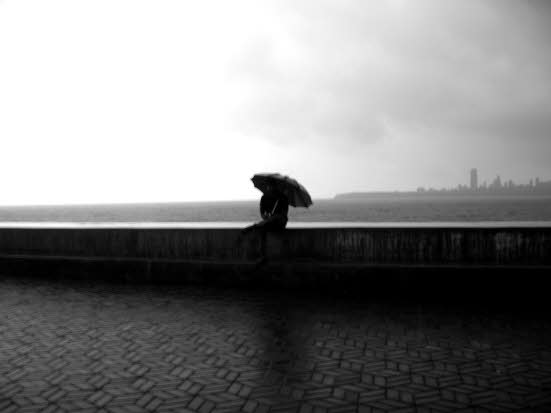by Parth Pandya
Mumbai is a sin city. Let no one tell you otherwise. It may never have put a clarion call to welcome the tired and the huddled masses into its arms, but the oppressed and the oppressor have nevertheless made their way and staked their claim on the seven islands. Day after day, the city extracts its pound of flesh for the chance to survive in it. Each year, the crimes pile on, staining the fabric of everyday life in the metro. Each year, the purge arrives in the form of the rains. As millions of drops beat down at the same time, the city gets a clean coat, a clean slate to write on.
Like everything else in Mumbai, the rains are also nothing short of dramatic. Half measures are not allowed and drizzles are frowned upon by the rain Gods. Why drip when you can pour? The darkening of the skies, the trembling sounds of thunder and the cooling of the air build up the suspense to the event. The mood is grim and exciting at the same time, the senses tingle in expectation, as if this were a Bollywood movie where you know that a gloved hand with a knife is going to appear to do its deed. People stare up, trying to gauge if it is just a threat, or if they erred by leaving the house without an umbrella. Everyone trusts their internal rain gauge, until it fails them miserably one day.
And then it comes, the initial droplets and the quick acceleration to the final downpour. The pounding begins and it is relentless. Did you learn the nursery rhyme about the ‘pitter-patter raindrops’ as a kid? You’ll know what the pitter-patter is all about as the rhythmic fall of the raindrops on the coloured and black umbrellas makes that sound. The umbrella holders trudge through, managing their belongings with the other free hand. The foolish bravehearts who left their home with nothing to cover them, protect their heads with various concoctions – a set of books, a plastic bag, an office briefcase – and scamper into the nearest building they can find. It is not unusual to see a bunch of folks lined up at the tiny entrances of these buildings where they give each other and the old circuitry company. Slowly but surely, the water starts to accumulate on the roads. If you are in an autorickshaw, you curse the fact that even the most stringent velcro-strapped curtains won’t protect you from getting wet. When you are getting off the bus, you feel the intense pressure of opening your umbrella in the micro-second, after which, more often than not, you’ll be emptied onto the road with your precious body left to ravage in the rain. Those inside their houses scamper to get the clothes off the clothes line, lest they get wet in the downpour. If you are in a local train, you pray that the tracks aren’t inundated and that you can reach home safely.
The rains might be a great source of joy and excitement, but in a city like Mumbai, the after-effects sometimes are not. The city shouldn’t clog up with the pace that it does, but, unfortunately, nothing short of a quick filling up of water ever happens. The city’s drainage system is antiquated, there is lot of unplanned development, especially in the northern suburbs, and to make matters worse, the mangrove ecosystems have slowly been replaced with construction. No one relishes the news that the Powai Lake is about to overflow or that the sewage system will be overflowing and that housing societies need to add chlorine to their water tanks. All this and much more happened in recent memory, in July of 2005. It was a perfect storm, with record rains pounding Mumbai relentlessly and the inherent drawbacks explained above contributing to the catastrophe. People’s houses were flooded, there was significant loss of life and property, and even essential services were disrupted. July 26th became a landmark day in Mumbai’s history. Bollywood, never shy to miss out on an opportunity, made two movies (“26 July at Barista” and “Tum Mile”) on the topic.
There is the fury of Mother Nature and there are the frailties of human nature; yet, many a time, they combine spectacularly to make the monsoons memorable in Mumbai. Which resident of the city hasn’t got memories enriched by the rains? You can’t be a Mumbaikar (or a Bombayite if you prefer that) and not feel the romance of the rains.
 Ever watched the splashing of waters on Marine Drive during the rains or prayed hard as a kid that the rains wouldn’t stop so that the nullah on the way to school would overflow? Ever kicked a soccer ball around in the slush with your building friends or walked on the beach with rains and a strong breeze for company? Shared an umbrella with someone knowing fully that neither has a chance of staying dry? Walked your way from Andheri station in knee deep waters? Known that Milan subway would flood up quicker than a blazing century from Tendulkar? Decided to walk up a long distance in water to surprise your sweetheart knowing fully well that Bruhanmumbai Mahanagar Palika (Municipal Corporation of Greater Mumbai) has most likely left a few holes open along the way for you to magically avoid? I know I have. At the end of day, this Mumbai boy looks at the rain outside his house in Seattle and knows that it is a poor imitation of the rains he once embraced with arms open wide. Maximum City, as Mumbai is called, is nothing but maximum, when it comes to the rains!
Ever watched the splashing of waters on Marine Drive during the rains or prayed hard as a kid that the rains wouldn’t stop so that the nullah on the way to school would overflow? Ever kicked a soccer ball around in the slush with your building friends or walked on the beach with rains and a strong breeze for company? Shared an umbrella with someone knowing fully that neither has a chance of staying dry? Walked your way from Andheri station in knee deep waters? Known that Milan subway would flood up quicker than a blazing century from Tendulkar? Decided to walk up a long distance in water to surprise your sweetheart knowing fully well that Bruhanmumbai Mahanagar Palika (Municipal Corporation of Greater Mumbai) has most likely left a few holes open along the way for you to magically avoid? I know I have. At the end of day, this Mumbai boy looks at the rain outside his house in Seattle and knows that it is a poor imitation of the rains he once embraced with arms open wide. Maximum City, as Mumbai is called, is nothing but maximum, when it comes to the rains!
Parth Pandya is a passionate Tendulkar fan, diligent minion of the ‘evil empire’, persistent writer at http://parthp.blogspot.com, self-confessed Hindi movie geek, avid quizzer, awesome husband (for lack of a humbler adjective) and a thrilled father of two. He grew up in Mumbai and spent the last eleven years really growing up in the U.S. and is always looking to brighten up his day through good coffee and great puns.
[facebook]Share[/facebook] [retweet]Tweet[/retweet]






I have been through thunderstorms and worse, but nothing compares to the sustained, visibility reducing rains in Mumbai. It’s almost as if the water forms a wall that you have to break through to walk. Miss it terribly though. 🙂